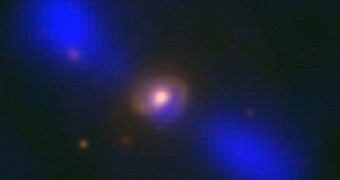A recent paper in the journal Monthly Notices of the Royal Astronomical Society tells the tale of an odd galaxy that is now busy coughing out subatomic particles at nearly the speed of light, i.e. nearly 300,000,000 meters per second / 985,000,000 feet per second.
The galaxy in question is located at a distance of about 800 million light-years from our planet, astronomers with the National Radio Astronomy Observatory explain. It is a spiral galaxy and its official name is J1649+2635.
A peculiar spiral galaxy indeed
In their paper in the journal Monthly Notices of the Royal Astronomical Society, the researchers behind this discovery explain that, more often than not, spiral galaxies like to spend their time simply birthing stars and witnessing their demise.
Thus, it's elliptical galaxies that come into being when spiral ones collide and merge with each other that have a knack for birthing jets of subatomic particles and propelling them into space, the astronomers go on to detail.
Spiral galaxies that share this talent are so rare that just four have been discovered thus far, J1649+2635 included. Of the other three such galaxies until now documented by science, one was discovered in 2003, one in 2011, and one earlier this year.
Interestingly enough, J1649+2635 is the first jets-spewing galaxy to be labeled as such after being first documented as a self-standing spiral galaxy. Otherwise put, astronomers first discovered the galaxy and only later noticed its odd behavior.
“This is the first time that a galaxy was first identified as a spiral, then subsequently found to have large radio jets,” researcher Ryan Duffin said in a statement. “It was exciting to make such a rare find,” the astronomer went on to comment on this discovery.
So, what's the deal with these jets?
As mentioned, the jets stemming from J1649+2635 comprise subatomic particles moving at nearly the speed of light. In the National Radio Astronomy Observatory image included in the gallery below, these jets are depicted in blue.
The thing is that, for the time being at least, scientists cannot say for sure how and why the galaxy ended up birthing these jets. They say that, in order to gain a better understanding of this phenomenon, they need to find and study several other such galaxies.
As explained by researcher Minnie Mao, “We don't know how spirals can have these large jets. In order to figure out how these jets can be produced by the ‘wrong’ kind of galaxy, we realized we needed to find more of them.”
Evidence at hand indicates that jets of subatomic particles such as the ones originating from J1649+2635 form from rapidly rotating material and are propelled into space by the gravitational energy of a supermassive black hole.
The trouble is that, in the case of spiral galaxies, the birth of such jets should rip through their home system. How and why J1649+2635 not only survived the experience but also managed to maintain its shape remains a mystery.

 14 DAY TRIAL //
14 DAY TRIAL // 



